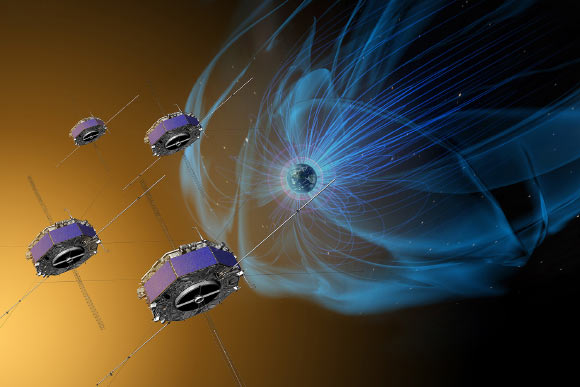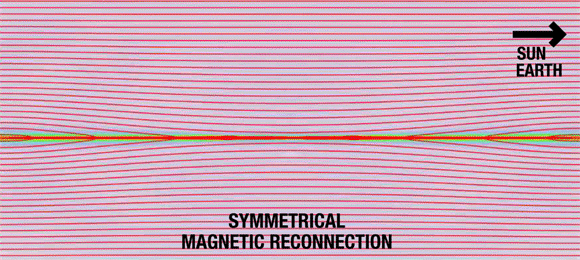NASA’s Magnetospheric Multiscale (MMS) mission consists of four identical spacecraft that orbit around Earth through the dynamic magnetic system surrounding the planet to study a type of space explosion called magnetic reconnection, a common event throughout the Universe that occurs when magnetic fields change by connecting and then breaking apart. The MMS satellites just witnessed such an explosion in a unique location — the Earth’s magnetotail, the part of the magnetic environment trailing behind the planet, away from the Sun.

The four MMS spacecraft — shown here in an artist’s concept — have made more than 4,000 trips through the boundaries of Earth’s magnetic field. Image credit: NASA / Goddard / Conceptual Image Lab.
Magnetic reconnection occurs around Earth every day due to magnetic field lines twisting and reconnecting. It happens in different ways in different places, with different effects.
Particles in highly ionized gases, called plasmas, can be converted and cause a single powerful explosion, just a fraction of a second long, that can lead to strong streams of electrons flying away at supersonic speeds.
NASA’s four MMS satellites have spent the last three years studying magnetic reconnection in the near-Earth environment.
For the first half of the mission, the satellites studied reconnection that occurs in the sunward side of Earth where the solar wind pushes into Earth’s magnetic field.
The two sides connecting have different densities, which cause magnetic reconnection to occur asymmetrically, spewing electrons away at supersonic speeds.
In the magnetotail, the trailing portion of the magnetosphere blown back by the solar wind, only the Earth’s field lines are colliding, so the particles are accelerated nearly symmetrically.
“On the sunward side, explosive magnetic reconnection events dump energy into Earth’s magnetosphere, the region surrounding the Earth dominated by its magnetic field,” said MMS deputy principal investigator Dr. Roy Torbert, a researcher in the Space Science Center at the University of New Hampshire.
“Reconnection on the night side is dumping energy into Earth’s atmosphere, as electrons travel down magnetic field lines and excite aurora.”

Behind Earth, away from the Moon, magnetic reconnection occurs symmetrically; this simulation shows particles traveling away from the site of reconnection equally in both directions, confined by the red magnetic field lines. Image credit: Michael Hesse / Joy Ng / NASA’s Goddard Space Flight Center.
The MMS satellites observed their first asymmetrical reconnection event on October 16, 2015, and now this fist symmetrical event on July 11, 2017.
“This was a remarkable event. We have long known that it occurs in two types of regimes: asymmetric and symmetric but this is the first time we have seen a symmetric process,” Dr. Torbert noted.
The view had enough resolution to reveal its differences from other reconnection regimes around the planet.
“This is important because the more we know and understand about these reconnections, the more we can prepare for extreme events that are possible from reconnections around the Earth or anywhere in the Universe,” Dr. Torbert said.
Dr. Torbert and colleagues found that the symmetrical reconnection events last only a few seconds, producing extremely high velocity electron jets — over 9,320 miles per second (15,000 km per second) — and intense electric fields and electron velocity distributions.
The observations are outlined in a paper published in the journal Science.
_____
R.B. Torbert et al. Electron-scale dynamics of the diffusion region during symmetric magnetic reconnection in space. Science, published online November 15, 2018; doi: 10.1126/science.aat2998







